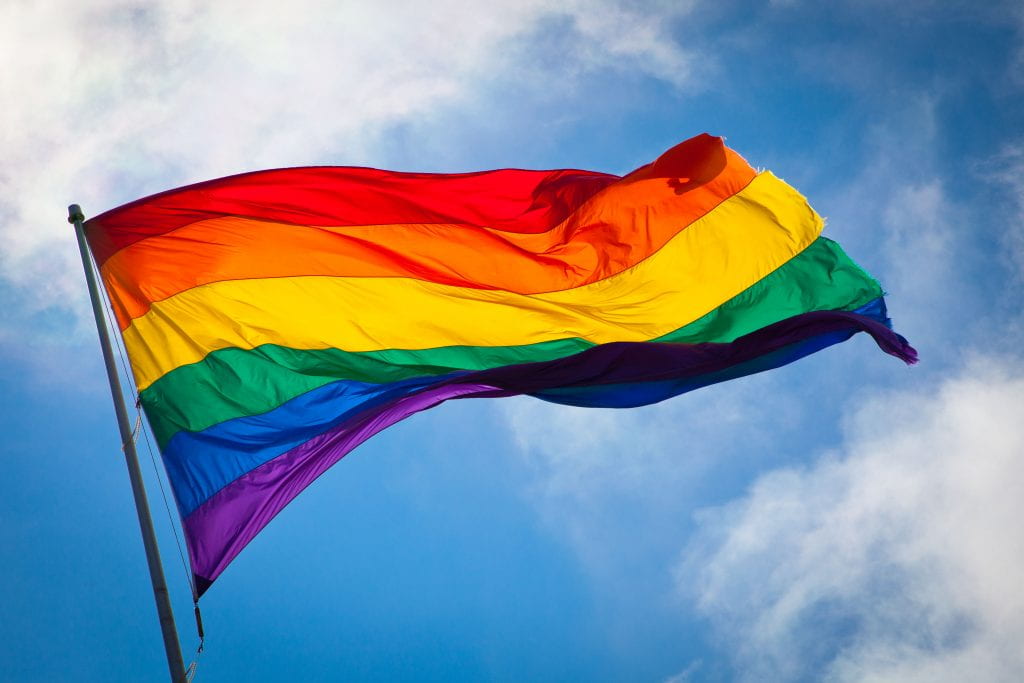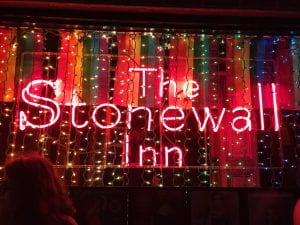
The month of June is known as Pride Month for the LGBTQ community. Pride means more than its dictionary definition to the LGBTQ community and has a long history.
The fight for marriage equality began in 2010 with United States v. Windsor. This case challenged the constitutionality of the Defense of Marriage Act (DOMA). This Act stated that only marriages between a man and a woman were recognized by the federal government, but allowed for state governments to recognize them. Edith Windsor was widowed after her spouse, Thea Clara Spyer, who passed away in 2009. She was the sole survivor of their estate. Windsor and Spyer were legally married in Canada in 2007, and their marriage was recognized by their home state of New York. Spyer left in her will that the estate would be left to Windsor, but because their marriage was not recognized by federal law, over $350,000 in estate taxes was issued to Windsor. If their marriage would have been recognized by the federal government, no taxes would have been issued.
Windsor filed a lawsuit against DOMA and its constitutionality in 2010. At that time, DOMA was upheld by the government; however, in 2011 President Obama and Attorney General Holder announced that they would no longer defend DOMA. The House of Representatives then created a provisionary group to defend DOMA but the district court found the group to be unconstitutional. Windsor was given a refund for the estate taxes she was forced to pay and DOMA was declared unconstitutional by the Supreme Court of the United States (SCOTUS). States were then allowed to issue marriage licenses to same-sex couples if their governments chose to allow such.
Efforts for marriage equality continued with James Obergefell and John Arthur James, who were residents of Ohio. They decided to go to Maryland to get legally married after years of being together when James was diagnosed as terminally ill. The couple wanted to designate Obergefell as the surviving spouse on the death certificate, but Ohio’s laws allowed for refusal of same-sex marriages and their recognition even if the couple was legally married in another state. Obergefell v. Hodges was brought to the South District Court of Ohio to challenge the state’s discrimination against same-sex couples. The Ohio Registrar agreed that the law was unconstitutional but the Ohio Attorney General decided to uphold the state’s same-sex marriage and recognition ban. The case continued through the fourth, sixth, seventh, ninth, and tenth circuit courts of Ohio. All but the sixth circuit court agreed that the state-level ban on same-sex marriage was unconstitutional. Because all of the courts did not rule the same, a Supreme Court intervention was inevitable. While the case was going through the circuit courts, James passed away.
During two years of appeals, Obergefell v. Hodges became larger. Plaintiffs of Bourke v. Beshear from Kentucky, DeBoer v. Snyder from Michigan, and Tanco v. Haslam from Tennessee were added. The plaintiffs in each of these cases had been denied marriage rights from their home state, even if their marriages happened in another, just as Obergefell had. It was in April of 2015 when Obergefell v. Hodges, which now consolidated the cases from all four states, presented oral arguments to the Supreme Court of the United States (SCOTUS) to challenge the states’ same-sex marriage bans constitutionality. Two months later on June 25th, SCOTUS ruled that marriage is a constitutional right and ruled in favor of marriage equality. This allowed for same-sex marriages to be legalized by the government.
While the historic ruling by SCOTUS happened in 2015, June has been Pride Month for decades before marriage equality. We know Pride Month today as a month-long celebration full of parades, events, and parties. It did not begin that way. The first Pride Parade was a riot at the Stonewall Inn, which is known as “the place that Pride began.”

Stonewall Inn, New York City, 1969
It was illegal to engage in homosexual behavior, giving the police the “right” to attack anyone thought to be gay and arrest them. A majority of the gay bars and clubs had been raided and shut down by the New York City Police Department (NYPD). On the evening of June 28th, a group of people gathered at one of the few gay bars that remained open, The Stonewall Inn. The police barged in shouting, “We’re taking the place!” The patrons then began to resist. As those who were at the Stonewall Inn were arrested, a large crowd formed outside of Stonewall. Marsha P. Johnson, a transgender woman of color and LGBTQ activist was outside. She threw the first brick in protest and ignited the Stonewall Riots. The riots were eventually doused that evening by police reinforcements but protesters returned the next night with over 1,000 people filling the streets. The people of Stonewall emerged victorious by fighting back. As a result of the riots, the police ceased to interfere with LGBTQ safe spaces and no longer attacked them on the streets; and by making headlines across the country, LGBTQ issues were brought to the forefront, organizations were started, and the community began to fight for their rights. The Stonewall Riots began the LGBTQ movement.
Marches, today known as Pride marches, sparked across the US when news spread of the riots. The Stonewall Riots were violent; however, they ignited a nonviolent movement across the nation and world. June has been deemed Pride Month in honor of the riots.
A Symbol of Unity, Hope, and Safety
The first Pride Flag was designed by Gilbert Baker in 1978, in San Francisco. It was in honor of Harvey Milk, who was elected to the San Francisco Board of Supervisors. Milk tasked Baker with drafting up a design for his campaign. His platform was hope for the young gay people, saying, “The only thing they have to look forward to is hope, and you have to give them hope.” Thus, the Pride Flag was born. Milk was the first openly gay person to hold public office in a major US city and was later assassinated for that same reason. After his death, the Pride Flag production increased. Businesses all over San Francisco were flying them proudly in remembrance of Milk. “The flag is an action – it is more than just a cloth and the stripes. When a person puts the Rainbow Flag on his car or his house, they’re not just flying a flag. They’re taking action,” Baker said, “I am astounded that people just got it…that this was their flag. It belonged to all of us.”
The original Pride Flag had seven colors, with fuchsia, which represented sexuality, at the top. However, due to a shortage of fuchsia in the factory where it was reproduced, it was condensed to the six-color flag that flies today. The remaining six colors also represent something powerful and meaningful to the LGBTQ+ community. Red stands for life. To some people, coming out as LGBTQ can mean life or death. In a lot of scenarios, when one comes out their family shuns them, kicks them out, and/or verbally abuses them. This pushes a lot of youths to suicide. Suicide is the 2nd leading cause of death among young people, and LGBT youth are four times likelier to attempt than straight youths, according to Innerbody Research. Red represents the importance of life, and how giving up on it is never the answer. Orange represents healing powers of love in the community. Yellow is for sunlight. It is a metaphor for being yourself rather than hiding in the shadows. Green stands for nature and everyone’s ties to it. Blue represents serenity, which is defined as a state of being calm, peaceful, and untroubled. Finally, violet stands for spirit, which is the most important of all the colors, as the spirit unique and inalienable.
Other symbols of Pride and safe-spaces have also emerged in the past few years. Organizations like the Human Rights Campaign have trademarked the yellow equal sign with a blue background. This symbol is known in the United States but the Pride Flag remains the prominent international symbol.

Progress has been made for the LGBTQ community, but there have been large setbacks as well. During Pride Month last year, 49 lives were taken at Orlando’s Pulse Nightclub in the deadliest mass shooting in modern-US history that took place during Orlando’s Pride celebrations. Sean Kennedy was another hate-crime victim. In 2007, he was leaving a bar in South Carolina when he was attacked for his sexuality and died as a result of it. In 1998, Matthew Shepard made headlines across the nation when he was found beaten, tortured, and left to die while tied to a fence in Wyoming.
The United Nations Universal Declaration of Human Rights (UDHR) sets fundamental human rights to be universally protected. During Stonewall, the Pulse Shooting, and the individual murders, many rights declared by the UHDR were violated:
- Article 3: Right to life, liberty, and security of person. The Stonewall Riots happened because queer folk had been attacked by the police without cause, violating their security of person. The Pulse Shooting and the Kennedy and Shepard murders were violations of the right to life.
- Article 5: No one shall be subjected to torture or to cruel, inhuman punishment. Shepard was tortured and brutally beaten before he died.
- Article 7: All are entitled without any discrimination and equal protection to of the law. In the case of Stonewall, NYPD had not only been attacking the LGBTQ community, they were being denied justice by not having their attackers persecuted.
- Article 9: No one shall be subjected to arbitrary arrest. The LGBTQ folk were being arrested for being LGBTQ in New York.
- Article 19: Everyone has the right to freedom of opinion and expression. Throughout history and in modern times, the LGBTQ community is targeted simply for existing.
There were many countries that gave same-sex couples the right to marry before the US. The Netherlands, in 2001, became the first country in the world to allow same-sex marriages. Many countries joined the Netherlands, including Canada, Belgium, France, and Ireland to name a few (You can see the timeline of when countries allowed same-sex marriage here). Today, June 30, German Parliament voted to legalize same-sex marriage. That makes 22 countries in the last 16 years allowing same-sex marriages, which is important as it shows that the world is growing to be more accepting of the LGBTQ community. Countries that allow same-sex marriage gives validity to its citizens that identify as LGBTQ and promotes a more accepting environment. According to Forbes, when same-sex marriage is legal, LGBTQ youths are less likely to commit suicide and hate-crimes decrease.
In contrast to the 22 countries that allow and support same-sex marriage, there are 76 countries that have anti-LGBTQ laws in effect today. Last week, Turkish police shot rubber bullets at Pride Parade attendees and proceeded to detain who they could. In Chechnya, reports of a concentration camp for those who identify as homosexual made headlines as more than 100 men were abducted, tortured, and few were killed in a systematic purge of the LGBTQ community.
The world can be a scary place for someone who identifies as LGBTQ. It is imperative that those of us who can remain resilient and visible by not being afraid to show who you are. Showing up at Pride celebrations are easy ways to let the world know that the LGBTQ community exists, and gives comfort to those who cannot “come out”. That is exactly what Pride Month stands for. It is a time for us to unite and show our pride. Pride means strength, unity, and acceptance.
